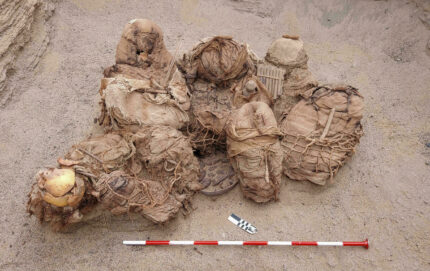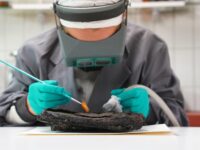800-Year-Old Tomb Discovered in Peru
LIMA, PERU—The remains of eight people estimated to be 800 years old were discovered by workers laying gas pipes near Lima, according to an ...
Friday
800-Year-Old Tomb Discovered in Peru
600-Year-Old Muisca Jars Recovered in Colombia
Human Footprints in North America Dated to 23,000 Years Ago
September Quiz
source http://www.historytoday.com/archive/interactive/september-quiz
Gas pipe workers find 800-year-old burial bundles
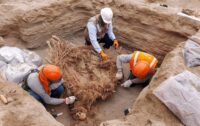
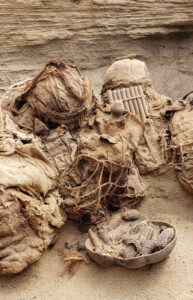
Inside some of the bundles archaeologists found hand spindles, used to spin cotton, camelid or sheep’s wool into the richly colored and patterned textiles that have been characteristic of Andean culture for millennia. They also found chuspas, pouches used to carry coca leaves and the alkaline substances (lime in this case) they were chewed with to increase the practice’s effectiveness against altitude sickness, in some of the bundles.
The bundles were placed inside a chamber dug into the sand, then topped with wood logs and mats of plant fiber hardened with mud. Archaeologists believe the burials were part of a pre-Hispanic cemetery in Chilca, as bodies have been found during utility work before, most recently in 2018 when Cálidda workers discovered the ancient remains of 30 individuals.
The human remains and archaeological materials will be entrusted to experts at Peru’s Ministry of Culture, who will assess their conservation needs and determine where they will be exhibited in the future.
source http://www.thehistoryblog.com/archives/62310
Gas pipe workers find 800-year-old burial bundles


Inside some of the bundles archaeologists found hand spindles, used to spin cotton, camelid or sheep’s wool into the richly colored and patterned textiles that have been characteristic of Andean culture for millennia. They also found chuspas, pouches used to carry coca leaves and the alkaline substances (lime in this case) they were chewed with to increase the practice’s effectiveness against altitude sickness, in some of the bundles.
The bundles were placed inside a chamber dug into the sand, then topped with wood logs and mats of plant fiber hardened with mud. Archaeologists believe the burials were part of a pre-Hispanic cemetery in Chilca, as bodies have been found during utility work before, most recently in 2018 when Cálidda workers discovered the ancient remains of 30 individuals.
The human remains and archaeological materials will be entrusted to experts at Peru’s Ministry of Culture, who will assess their conservation needs and determine where they will be exhibited in the future.
from The History Blog https://ift.tt/39wgHx5
Dark Destiny!
DARK DESTINY, the third and final book in my Young Adult time travel trilogy, was released yesterday! I'm so happy that this series is now available. I really enjoyed writing about these valiant young people learning to manage their unnerving talents and growing together as they fulfill their vows to aid their country in time of war.
As I've said before, I've always been intrigued by the parallels between the Napoleonic wars and World War II because both times Britain stood alone against a Continental tyrant, protected only by the narrow strip of sea known as the English Channel.
Much of Great Britain's history is informed by its island status. Dark Mirror, first in the Lackland Abbey Chronicles, had a grand action finale involving Dunkirk as hundreds of thousands of troops were evacuated across the Channel to Britain.
Both Dark Mirror and the second book, Dark Passage, had my young Regency mages going
This was a very real threat. I love these two quotes from that time, which are an epigraph for Dark Destiny:
“Let us be masters of the Channel for six hours and we are masters of the world.”
Napoleon Bonaparte while contemplating an invasion of Britain
“I do not say, my Lords, that the French will not come. I say only they will not come by sea.”
Admiral Lord John Jervis, Earl of St Vincent, when he was Admiral of the Channel Fleet during the Napoleonic Wars
The story includes Tory and Allarde and their other friends from Merlin's Irregulars, but an important new character is Rebecca Weiss, from 1940. The Irregulars rescued Rebecca and her family from Nazi imprisonment in Dark Passage, and Rebecca will risk her life by traveling back to 1804 so she can use her fledgling telepathic talents to try to turn Napoleon's ambitions away from Britain.
Here's an excerpt from the beginning of Dark Destiny:
Lackland, England, Autumn 1940
A fighter plane roared menacingly over the farmhouse just as Tory bent to blow out the candles on her birthday cake. She froze—she would never get used to destructive flying machines!
But she could pretend to be brave. She drew a deep breath and blew. The seventeen candles for her years were easily extinguished, but the one added for luck flickered persistently before guttering out. She hoped that wasn’t an omen.
Her friends around the table applauded. Those who’d come from 1804 with Tory were enjoying the twentieth century birthday customs. The five of them would return to their own time in the morning. She was glad to be heading home, but she’d miss her twentieth century friends.
“Did you make a wish?” Polly asked. The youngest Rainford, she belonged to this house and this time. Though she was still weak from a bout with blood poisoning that had almost killed her, her mischievous smile had returned.
“Indeed I did,” Tory replied. “And it was hard to decide what to wish for!”
Her life had changed so much since she turned sixteen a year ago. Then she had been the well brought up Lady Victoria Mansfield, youngest child of the Earl of Mansfield. Most of her thoughts had been turned toward her upcoming presentation to society where she would look for the best possible husband.
In the year since, she’d become a mageling, an exile, and one of Merlin’s Irregulars, sworn to use her magic to protect Britain. Not to mention being a traveler through time and an unsung heroine of Britain.
Best of all, she had fallen in love. Her gaze drifted to the young man who sat at her right, looking impossibly handsome. Justin Falkirk, Marquess of Allarde and her beloved. He gave her a smile full of the warmth and intimacy that had grown between them in the last months.
“Time to cut the cake!” Lady Cynthia Stanton, who was Tory’s roommate back at the Lackland Academy, was eyeing the dessert hungrily. “Mrs. R., if I come back for my birthday, will you make me a cake like this?”
“I will,” their hostess said cheerfully. “But give me some warning, please. This cake required almost a month’s worth of our sugar rations. I’ll need to save more coupons to create another cake this size.”
“You won’t want to take another beastly trip through the mirror just for a cake, Cynthia.” Tory got to her feet so she could cut properly. “But you can have the first piece of this one.”
The round cake had a thin layer of white icing and “Happy birthday, Tory!” was spelled out in rather uneven red letters. The same red icing had been used to draw little red rockets exploding around the edges.
Tory could have done without the explosions, but Polly had been pleased with herself for coming up with the idea. After all, war had drawn together this group of magelings from two different eras, and had forged lasting friendships.
Mrs. Rainford was sitting on Tory’s left, and she held out a small plate to receive the first slice. “Here you are, Cynthia,” Tory said as she set the wedge of dark fruitcake on the plate. Mrs. Rainford handed it across the table.
“I’m going to have trouble waiting until everyone is served!” Cynthia exclaimed. “I still haven’t recovered from burning so much magic in France.”
“As the birthday girl, I give you permission to eat now rather than wait for the rest of us,” Tory said grandly. “We all need to eat to build up our strength for the return journey through the mirror.”
There's lots of action and developing romance, and of course happy endings!
All three stories are available as ebooks, audio books, and print on demand. (The PODs might take a bit of time to become available.) I had fun working on the new covers with the wondrous Kim Killion. The same young model was used for all three of the covers. The magic pizzazz was added by Kim.
I'll give a free copy of Dark Destiny, either ebook or original print, to one person who leaves a comment between now and Saturday night. US only, sorry!
You may not usually read fantasy, time travel, or young adult novels, but if you like the kinds of characters and action I write in my adult books, you may enjoy these stories as well. Start with Dark Mirror and see what you think!
Mary Jo
source https://wordwenches.typepad.com/word_wenches/2021/09/destiny.html
Thursday
Long-Distance Trade Detected in Genomes of Siberian Dogs
Composition of Stone Tools From Roman Morocco Analyzed
New Thoughts on Maya Pyramid in El Salvador
This Civil War–Era Eagle Sculpture Was Made Out of Abraham Lincoln's Hair
from History | smithsonianmag.com https://ift.tt/3kzA1A7
Roman gold coins found off coast of Spain
A group of 53 Roman gold coins have been discovered on the seabed off the coast of Xàbia in Alicante, southeastern Spain. They are gold solidi ranging in date from the late 4th to the early 5th century, and are in such excellent condition that all the coins but one could be identified. There are three solidi from the reign of Emperor Valentinian I, seven from Valentinian II, 15 from Theodosius I, 17 from Arcadius and 10 from Honorius.
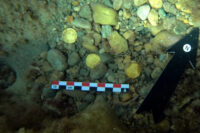
When they returned to the boat, they saw that they were ancient gold coins bearing identical profiles of a Roman emperor. They immediately alerted city officials to their discovery and led marine archaeologists to the find site. Over several dives, the team of archaeologists recovered the 53 gold coins, three copper nails and fragments of lead that may have been fittings on a chest.
This is one of the largest sets of Roman gold coins found in Spain and Europe, as stated by Professor in Ancient History Jaime Molina and University of Alicante team leader of the underwater archaeologists working on the wreck. He also reported that this is an exceptional archaeological and historical find, since it can offer a multitude of new information to understand the final phase of the fall of the Western Roman Empire. The historians point to the possibility that the coins may have been intentionally hidden, in a context of looting such as those perpetrated by the Alans in the area at that time.
Therefore, the find would serve to illustrate a historical moment of extreme insecurity with the violent arrival of the barbarian peoples (Suevi, Vandals and Alans) in Hispania and the final end of the Roman Empire in the Iberian Peninsula from 409 A.D.
The coins are now being conserved and studied before going on display at the Soler Blasco Archaeological and Ethnographic Museum in Xàbia, conditioned on the acquisition of an armored glass case equipped with sensors to secure the valuable (and easily meltable) artifacts. Funding has already been secured to return to the find site for a more thorough excavation.
from The History Blog https://ift.tt/3o17aXs
Roman gold coins found off coast of Spain
A group of 53 Roman gold coins have been discovered on the seabed off the coast of Xàbia in Alicante, southeastern Spain. They are gold solidi ranging in date from the late 4th to the early 5th century, and are in such excellent condition that all the coins but one could be identified. There are three solidi from the reign of Emperor Valentinian I, seven from Valentinian II, 15 from Theodosius I, 17 from Arcadius and 10 from Honorius.

When they returned to the boat, they saw that they were ancient gold coins bearing identical profiles of a Roman emperor. They immediately alerted city officials to their discovery and led marine archaeologists to the find site. Over several dives, the team of archaeologists recovered the 53 gold coins, three copper nails and fragments of lead that may have been fittings on a chest.
This is one of the largest sets of Roman gold coins found in Spain and Europe, as stated by Professor in Ancient History Jaime Molina and University of Alicante team leader of the underwater archaeologists working on the wreck. He also reported that this is an exceptional archaeological and historical find, since it can offer a multitude of new information to understand the final phase of the fall of the Western Roman Empire. The historians point to the possibility that the coins may have been intentionally hidden, in a context of looting such as those perpetrated by the Alans in the area at that time.
Therefore, the find would serve to illustrate a historical moment of extreme insecurity with the violent arrival of the barbarian peoples (Suevi, Vandals and Alans) in Hispania and the final end of the Roman Empire in the Iberian Peninsula from 409 A.D.
The coins are now being conserved and studied before going on display at the Soler Blasco Archaeological and Ethnographic Museum in Xàbia, conditioned on the acquisition of an armored glass case equipped with sensors to secure the valuable (and easily meltable) artifacts. Funding has already been secured to return to the find site for a more thorough excavation.
source http://www.thehistoryblog.com/archives/62305
Review of The Bombay Prince by Sujata Massey, a mystery of 1920s India
This historic event is the setting for the third in Sujata Massey’s excellent mysteries of 1920s India featuring Perveen Mistry, the country’s first female solicitor (she’s fictional but based on a real-life figure).
Miss Freny Cuttingmaster, a talented student at Woodburn College, stops by Mistry Law for a legal consultation with Perveen. She and her classmates are required to attend the parade celebrating the Prince of Wales’s arrival in Bombay, but Freny detests what he symbolizes and wants to stay away. Impressed by her principles, Perveen advises her as best she can. Then, on the day of the procession, poor Freny’s body is found on the ground, beneath a balcony on her campus. Was her death suicide-as-protest, a political murder, or something else?
Massey admirably directs a cast of dozens, all with distinct personalities and with a range of religious backgrounds. The amount of cultural information smoothly woven through these pages is astounding and is exhibited via the characters’ interactions. The Cuttingmasters are Parsis, like Perveen, which leads her and her lawyer father, Jamshedji, to advocate for Freny’s distraught parents during the coroner’s inquest and ensure her funeral at Doongerwadi isn’t improperly delayed. Feeling an affinity for their late daughter, Perveen wants to see justice done, but she’s disconcerted by Mr. Cuttingmaster’s abruptness (he’s a tailor, as his name suggests) and tries to act without causing offense. She doesn’t always succeed.
Perveen’s manner feels stiff at times, which she acknowledges; it feels appropriate to her status as a pioneering woman in her field who happens to be separated from an abusive husband. Both on the job and within society, her behavior must be above reproach, plus Jamshedji disapproves of her socializing with men. This includes Colin Sandringham, an English political agent helping to arrange the prince’s itinerary. Readers of the previous book will be happy to see him again. Perveen and Colin had become close during her trip to Satapur, but as for a relationship between them – there be danger ahead, she knows.
Followers of the series should delight in how this book ends, and anyone tempted by mentions of the delicious Indian dishes consumed by the characters can find recipes on the author’s website.
from Reading the Past https://ift.tt/39ty69E
Wednesday
DNA Analysis Identifies Japanese Ancestors
Ritual Objects Discovered in Northern Egypt
'Band of Brothers' Stars Reflect on the Epic Miniseries' Evolving Legacy
from History | smithsonianmag.com https://ift.tt/3ufuj9T
‘Cake mummy’ survived WWII bombing of Lübeck
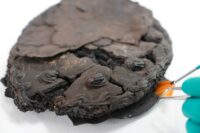
City archaeologists unearthed the cake in April during an excavation under a house on the Alfstrasse, a street that leads from the Trave river to Lübeck’s iconic 13th century St. Mary’s Church. Built in 1159, barely 15 years after the city’s founding, Alfstrasse is one of the oldest streets in the Lübeck located in the very heart of the city’s founding district.
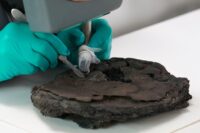
“From the point of view of a restorer, it is the most exciting object that I have ever worked on,” says [conservator Sylvia] Morgenstern. “I first have to wait for the laboratory analyzes. Only then can I decide whether I can clean the find with water and which substance is suitable for stabilization,” she says.
But just like the question of preserving the cake, the archaeologists are concerned with the story behind it. In addition to the charred cake, a coffee service and several records were also found. “Possibly the pastry was intended for a confirmation ceremony. It used to take place on Palm Sunday,” said Schneider. “We hope that we can clarify this with the help of the city archives at some point.” […]
“The cake find is so special because it goes back to an event – namely the bombing raid on Lübeck – that is still present in the minds of the city,” says Doris Mührenberg, who is in charge of the Lübeck Archeology magazine. This is where the “cake mummy” will later find its place – if it is possible to preserve it permanently.
from The History Blog https://ift.tt/3tXkvRC
‘Cake mummy’ survived WWII bombing of Lübeck

City archaeologists unearthed the cake in April during an excavation under a house on the Alfstrasse, a street that leads from the Trave river to Lübeck’s iconic 13th century St. Mary’s Church. Built in 1159, barely 15 years after the city’s founding, Alfstrasse is one of the oldest streets in the Lübeck located in the very heart of the city’s founding district.

“From the point of view of a restorer, it is the most exciting object that I have ever worked on,” says [conservator Sylvia] Morgenstern. “I first have to wait for the laboratory analyzes. Only then can I decide whether I can clean the find with water and which substance is suitable for stabilization,” she says.
But just like the question of preserving the cake, the archaeologists are concerned with the story behind it. In addition to the charred cake, a coffee service and several records were also found. “Possibly the pastry was intended for a confirmation ceremony. It used to take place on Palm Sunday,” said Schneider. “We hope that we can clarify this with the help of the city archives at some point.” […]
“The cake find is so special because it goes back to an event – namely the bombing raid on Lübeck – that is still present in the minds of the city,” says Doris Mührenberg, who is in charge of the Lübeck Archeology magazine. This is where the “cake mummy” will later find its place – if it is possible to preserve it permanently.
source http://www.thehistoryblog.com/archives/62298
Am I my heroines?
Anne here, and today I'm responding to a question from Quantum (for which he's won a book): "When reading your books I often wonder whether you imagined yourself as the heroine while writing, imbuing her with qualities that you have or would like to have. Daisy the seamstress is a favorite and perhaps you are stitching ideas together like Daisy making dresses."
I had to really think about this. When I'm writing, I try to imagine myself into each of the characters — not that the characters are me in any way, but that to access them, I have to 'dream' my way into them and how they are feeling, thinking etc. But it's not much different to the way I imagine myself into the places in the books, when I haven't been able to visit them in person.
It's a common belief that writers base their characters on real people, but all I can say is that it's not true for me at all. The closest I get to using real people in my books is pinching their name for characters, and I only do that with friends' names and then only for minor characters. (For instance, Sir Alan and Lady Reynolds who give a party in The Scoundrel's Bride. See also who I dedicated the book to.) I also borrow physical characteristics from actors sometimes, but mainly it's the mood of the photo that inspires me, like the one above.
When I was first published a good friend who loves psychology examined my first book with an assumption that the heroine was some form of me. She was a little perplexed. Then she read the second book, and then the next, still looking for me-as-character. I'm not sure when she gave up looking for evidence that they were some version of me, but she did quite early on.
There is obviously some part of me in all my characters — they come from my imagination, after all. Some have my sense of humor, some respond to the events and situations in the book as I might, but mostly my characters do and think things I would never do. Occasionally they do things I would love to be able to do — like come up with instant snappy comebacks in dialogue. In real life I often only think of the perfect comeback an hour or two later, or even at 2am. But generally they are who they are. Other writers I've talked to about this have similar responses — I suppose it's where the notion of "a muse" comes from.
Some of my main characters spring to life more or less fully formed on the page. Others take longer to emerge, and I ask myself questions about them, and what they are feeling at any point in the story. I build up a picture in my mind of who they are and what makes them tick. Even then, some can surprise me.
I remember when I was writing The Spring Bride, and Jane said to Zachary Black — "Oh grow up!" In the scene she and the hero are arguing over her decision to make a practical marriage. Up to that point she'd been sweet and cooperative and her spurt of temper took me as much by surprise as it took Zachary. I know that sounds weird, when Jane was my creation, but one of the joys of writing is when a character takes on a life of their own.
And some readers wrote to me, saying how much they liked that point where, to quote a couple of them, "Jane grew a backbone."
Here's that scene:
“You make it sound so cold-blooded, and I’m not,” Jane said.
He laughed, a short, hard sound. “Yes you are. Still, you deserve better than a fellow like Cambury. You can’t let yourself be sold off like this—”
“Oh, grow up!” she snapped.
His jaw dropped. “What?”
“I said grow up! Oh, it’s all so easy from where you stand, isn’t it, Mr. Black? You look at me and see the fine clothes, and you see I’m living in a big house in the best part of town and you imagine it’s all so perfect, don’t you?”
“I—”
“You can’t possibly imagine—can you, Mr. Black?—that I might know what it is to be hungry, what it is to be cold, what it is to have nowhere safe to sleep at night—” She broke off and took a deep, steadying breath.
“I didn’t—”
“I have nothing, not a penny of my own but the allowance Lady Beatrice gives me—and she has no reason to give it—I am no kin to her. It is nothing but kindness—charity, if you will.” Her eyes glittered with unshed tears. Angry unshed tears.
“I have little education, no skills, nothing but my face to recommend me. Lady Beatrice has given me the opportunity to make the kind of marriage that will secure my future—mine and any children I might have—and neither you, nor anyone else, is going to stop me from having it, no matter how much I might—” She broke off, shaking her head. “Oh, please, just go. And don’t come back. I don't wish to see you ever again.”
* * * * *
Jane isn't the only character who has surprised me with something they said or did, or behaved differently from how I'd initially imagined them, but I won't bore you with endless examples. I will say, however, that the surprise often comes in a scene where I'm handwriting first (which I don't always do) so I guess my subconscious is kicking in. And when that happens, it's a real boost.
But rather than characters that are some version of me or even of someone I know, I would much prefer to write the kind of characters I would love to meet, characters who surprise and entertain me — like Lady Beatrice, for instance, the kind of woman who we'd never meet in life.
So in a way you're right, Quantum — I am a bit like Daisy the dressmaker. Sometimes the character (or in her case, the dress) comes to me wholly imagined, and other times, it comes of draping and pinning and snipping and trying out different fabrics and styles until the right one emerges. Thanks for the question.
Question for readers: Have you ever come across a character in a book who reminds you of someone you know? Do you like it or does it feel a bit weird? Or is there a character in a book that you'd love to meet, because they're nothing like the people you meet in real life?
source https://wordwenches.typepad.com/word_wenches/2021/09/am-i-my-heroines.html






